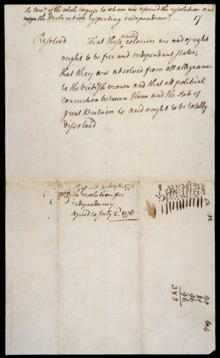
The Lee Resolution (also known as "The Resolution for Independancy") was the formal assertion passed by the Second Continental Congress on July 2, 1776 which declared the establishment of a new country of United Colonies as independent from the British Empire, creating what became the United States of America. News of this act was published that evening in the Pennsylvania Evening Post and the next day in the Pennsylvania Gazette. The text of the document formally announcing this action, the Declaration of Independence, was approved two days later on July 4, 1776 which is celebrated as Independence Day. The resolution is named for Richard Henry Lee of Virginia who proposed it to Congress, after receiving instructions from the Virginia Convention and its President Edmund Pendleton. Lee's full resolution had three parts which were considered by Congress on June 7, 1776. Along with the independence issue, it also proposed to establish a plan for ensuing American foreign relations, and to prepare a plan of a confederation for the states to consider. Congress decided to address each of these three parts separately.
On June 7, 1776, Lee proposed the following and it was seconded by John Adams:
Resolved, That these United Colonies are, and of right ought to be, free and independent States, that they are absolved from all allegiance to the British Crown, and that all political connection between them and the State of Great Britain is, and ought to be, totally dissolved.Find out more at: https://en.wikipedia.org/wiki/Lee_Resolution
That it is expedient forthwith to take the most effectual measures for forming foreign Alliances.
That a plan of confederation be prepared and transmitted to the respective Colonies for their consideration and approbation.
In the photo above:
"The resolution for independency agreed to July 2, 1776". The marks at the bottom right indicate the twelve colonies that voted for independence. The thirteenth colony, New York, abstained.

No comments:
Post a Comment